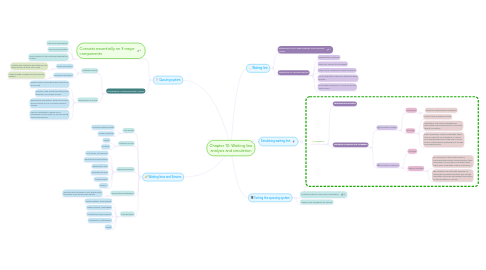
1. Queuing system
1.1. Consists essentially on 3 major components
1.1.1. The source population
1.1.2. The servicing system
1.1.3. The condition of the customers exiting the system
1.2. Components of Queuing System Visually
1.2.1. Customer arrival
1.2.1.1. Finite population
1.2.1.1.1. Limited-size customer pool that will use services and, at time, form a line.
1.2.1.2. Infinitive population
1.2.1.2.1. Large enough in relation to the services system.
1.2.2. Distribution of arrival
1.2.2.1. Waiting line formulas generally requires an arrival rate
1.2.2.2. Periodic, with exactly the same time between successive arrivals.
1.2.2.3. Exponential distribution: when arrivals at a service facility occur in a purely random fashion
1.2.2.4. Poisson distribution: where one is interested in the number of arrivals during some time period T
2. Waiting lines and Servers
2.1. Line length
2.1.1. Infinite potential length
2.1.2. Limited capacity
2.2. Number of lines
2.2.1. Single
2.2.2. Multiple
2.3. Queue Disciplines
2.3.1. First come, first service
2.3.2. Shortest processing time
2.3.3. Reservation first
2.3.4. Emergencies first
2.3.5. Limited needs
2.3.6. Others...
2.4. Service time distribution
2.4.1. The time the customer or unit spends with the server once service has started.
2.5. Line structure
2.5.1. Single channel, singe phrase
2.5.2. Single channel, multiphase
2.5.3. Multiphase, single channel
2.5.4. Multiphase, multichannel
2.5.5. Mixed
3. Exiting the queuing system
3.1. Customer return to the source population
3.2. Maybe a low probability for service
4. Waiting line
4.1. Waiting line is not a fixed condition of a productive system
4.2. Suggestion for managing queues
4.2.1. Segment the customer
4.2.2. Train your servers to be friendly
4.2.3. Inform your customers of what to expect
4.2.4. Try to divert the customer's attention when waiting
4.2.5. Encourage customers to come during the slack period
5. Simulating waiting line
5.1. Simulating
5.1.1. Spreadsheet SImulation
5.1.2. Simulation Programs and Languages
5.1.2.1. Simulation models
5.1.2.1.1. Continous
5.1.2.1.2. Discrete
5.1.2.2. Simulation programs
5.1.2.2.1. Purpose
5.1.2.2.2. Special purpose
